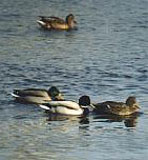| Contact us |
| Try wildfowling |
| Club merchandise |
| Wildfowl art |
| Wildfowling books |
| Join KWCA |
| Search |

The Bountiful coast
by Alan Jarrett
Autumn is a curious season in some ways. To the untrained eye it is the
start of the long months of decay that lie ahead before the renewals of
spring - but there is more to it than that. Autumn must also be bountiful
with a complex reservoir of foods laid down if the birds of winter are
to survive throughout the winter which is of course harshest season of
all.
I reflected on this just recently as I went to the shore in search of
bait for what was to prove an utterly unproductive fishing session. The
shore was tame and quiet in a way it often is before the storms of autumn
and winter approach.
As I rounded the edge of the seawall a swarm of crane flies rose from
the grass and rank growth to scatter this way and that in that inelegant
way so typical of this species. I watched them descend chaotically once
again into cover.
LOOKING BACK
It took my mind back some 20 years or more to when I had a place in a
fabulous fresh marsh shoot now sadly lost to our sport probably forever.
I had been working the marsh patiently for rabbits, which sat tight in
cosy seats and bolted if the dog pushed them out.
The grasses were full of crane flies that rose this way and that as I
progressed. At length a pair of mallard rose form the dry marsh for me
to clip one out with a very passable shot – especially when consideration
was given to the fact that I was using number 7 shot through a true cylinder
choke tube.
My eventual conclusion was that these and other mallard, which were also
about the marsh, were feeding on the crane flies. It was yet another demonstration,
if one were needed, that mallard are truly one of the supreme opportunists
of the bird world, which largely accounts for their great success worldwide.
The single successful shot at the mallard also further developed my small
shot/pattern kills method for effective wildfowling. It was a method which
I continued to explore until I hit on a deadly killing combination which
stood me in good stead over many years, until the ban on lead shot came
and threw the whole thing up in the air again!
BAIT DIGGING
Out on the flats away from the crane flies and the crunching shingle and
shell of the upper shore there were all the signs of approaching winter
in as much as Nature’s largesse seemed overwhelming. The renewal
of spring was here transposed by a mass of food awaiting the incoming
over-wintering hordes.
The lugworm beds, which even a few weeks before had seemed sparsely populated,
where now a dense mass of spiraled worm casts, although there was often
a degree of variation form one tide to another. The digging was easy,
and I soon had 100 fat worms to take to the southern coast in an attempt
to lure the first of the whiting.
Scattered throughout the muds were small ragworm - both red and white.
The surface of the mud was littered with winkles and the small snail hydrobia,
whilst just below the surface were cockles and the other common mollusc
of this coast macoma. There was thus a veritable feast awaiting the wader
flocks that were even now building up.
Closer inshore lay pools of standing water – ideally for washing
off mud-festooned fork and waders – whilst the flats all around had
lately turned a rich shade of green where a lush growth of zostera grew.
From where I stood it was possible to see right up the coast to the west
and the green zostera lawn grew as far as the eye could see.
FOMER DAYS
Thinking back perhaps 30 years the zostera grew all across these flats
and great companies of Brent geese and wigeon fed there. The geese and
wigeon still come, but the zostera beds are smaller and are sooner eaten
out by the hungry birds.
Often in years past I sat out on those flats under the October or November
moons in a grubby hole dug for the purpose. It was a work of art to find
the right place for the hole: if you got it right then it would be tolerably
comfortable; if you got it wrong then the hole might quickly fill with
water, or even worse the sides would collapse.
Even though the bag was never good they were wonderful experiences. There
is something about the moon shimmering off wet zostera flats and the wild
whistle of wigeon from here and there as they either flight to and fro
or feed beyond your night vision that seems unequaled in the wildfowling
world.
Perhaps this season I might try again and rekindle past glories. Thanks
to Nature’s bounty at least the opportunity will be there.